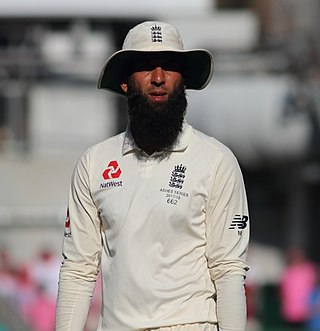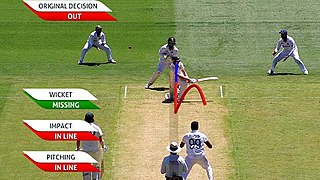
Fielding in the sport of cricket is the action of fielders in collecting the ball after it is struck by the striking batter, to limit the number of runs that the striker scores and/or to get a batter out by either catching a hit ball before it bounces, or by running out either batter before they can complete their current run. There are a number of recognised fielding positions and they can be categorised into the offside and leg side of the field. Fielding also involves trying to prevent the ball from making a boundary where four "runs" are awarded for reaching the perimeter and six for crossing it without touching the grass.

Backyard cricket, also known as bat ball, street cricket, beach cricket, corridor cricket, garden cricket, gully cricket and box cricket, is an informal variant of cricket. It is typically played in various non-traditional venues such as gardens, backyards, streets, parks, carparks, beaches, and any area not specifically designed for the sport.

Leg before wicket (lbw) is one of the ways in which a batter can be dismissed in the sport of cricket. Following an appeal by the fielding side, the umpire may rule a batter out lbw if the ball would have struck the wicket but was instead intercepted by any part of the batsman's body. The umpire's decision will depend on a number of criteria, including where the ball pitched, whether the ball hit in line with the wickets, the ball's expected future trajectory after hitting the batsman, and whether the batsman was attempting to hit the ball.

The wicket-keeper in the sport of cricket is the player on the fielding side who stands behind the wicket or stumps being watchful of the batsman and ready to take a catch, stump the batsman out and run out a batsman when occasion arises. The wicket-keeper is the only member of the fielding side permitted to wear gloves and external leg guards. The role of the keeper is governed by Law 27 and of the Laws of Cricket.

This is a general glossary of the terminology used in the sport of cricket. Where words in a sentence are also defined elsewhere in this article, they appear in italics. Certain aspects of cricket terminology are explained in more detail in cricket statistics and the naming of fielding positions is explained at fielding (cricket).

French cricket is a form of cricket that creates a game similar to catch. The game can be played socially at picnics and parties or on parks and beaches. It is a form of cricket that can include children of varied ages.
In the sport of cricket, the crease is a certain area demarcated by white lines painted or chalked on the field of play, and pursuant to the rules of cricket they help determine legal play in different ways for the fielding and batting side. They define the area within which the batsmen and bowlers operate. The term crease may refer to any of the lines themselves, particularly the popping crease, or to the region that they demark. Law 7 of the Laws of Cricket governs the size and position of the crease markings, and defines the actual line as the back edge of the width of the marked line on the soil, i.e., the edge nearest to the wicket at that end.

In cricket, batting is the act or skill of hitting the ball with a bat to score runs and prevent the loss of one's wicket. Any player who is currently batting is, since September 2021, officially referred to as a batter regardless of whether batting is their particular area of expertise. Historically, batsman and batswoman were used, and these terms remain in widespread use. Batters have to adapt to various conditions when playing on different cricket pitches, especially in different countries; therefore, as well as having outstanding physical batting skills, top-level batters will have quick reflexes, excellent decision-making skills, and be good strategists.

In cricket, a dismissal occurs when a batter's innings is brought to an end by the opposing team. Other terms used are the batter being out, the batting side losing a wicket, and the fielding side taking a wicket. The ball becomes dead, and the dismissed batter must leave the field of play for the rest of their team's innings, to be replaced by a team-mate. A team's innings ends if ten of the eleven team members are dismissed. Players bat in pairs so, when only one batter remains who can be not out, it is not possible for the team to bat any longer. This is known as dismissing or bowling out the batting team, who are said to be all out.

In cricket, the term bowled has several meanings. First, it is the act of propelling the ball towards the wicket defended by a batter.

In the sport of cricket, sledging is the practice of deliberately insulting or verbally intimidating an opposing player. The purpose is to try to weaken the opponent's concentration, thereby causing them to underperform or be more prone to error. It can be effective because the batsman stands well within hearing range of the bowler and certain close fielders, and vice versa. The insults may be direct or may feature in conversations among fielders which are intended to be overheard by the batsman. The term has also been used in other sports, as when the tennis player Nick Kyrgios insulted his opponent, Stan Wawrinka, by referring to a purported encounter between another player and the latter's girlfriend.

Stumped is a method of dismissing a batter in cricket, in which the wicket-keeper puts down the striker's wicket while the striker is out of their ground. It is governed by Law 39 of the Laws of Cricket.

Snickometer, commonly known as Snicko, is a system used in cricket to determine whether the ball edged the bat, for a potential dismissal such as a catch or leg before wicket. It does this by showing a frame-by-frame replay of the footage of the ball passing the bat alongside a waveform displaying the soundwave of an oscilloscope connected to a sensitive microphone near the stumps. The newer version currently in use is called Real Time Snickometer (RTS) and does not need to be manually synchronized for every piece of footage, making the process much faster. It was initially used for the broadcast team to attempt to determine whether the ball hit the bat and therefore if the umpire gave the correct decision. It is now also used for DRS reviews when the third umpire needs to determine whether the ball hit the bat, such as for when a ball is caught behind and the batsman might have edged the ball, or in the case of leg before wicket, where the batsman is not out lbw if the ball has hit the bat before it hit their body. It is used for this purpose in tandem with Hot Spot. It was invented by English computer scientist Allan Plaskett in the mid-1990s. The snickometer was introduced by Channel 4 in the UK, who also introduced the Hawk-Eye and the Red Zone, in 1999.

Moeen Munir Ali is an English cricketer, who was formerly vice-captain of England in limited overs cricket. He played for England cricket team between 2014 and 2024. In domestic cricket he represents Warwickshire, having previously played for Worcestershire. He has also played in multiple Twenty20 leagues, including for Royal Challengers Bangalore and Chennai Super Kings in the Indian Premier League.

Hot Spot is an infrared imaging system used in cricket to determine whether the ball has struck the batsman, bat or pad. Hot Spot requires two infrared cameras on opposite sides of the ground above the field of play that are continuously recording an image. Any suspected nick or bat/pad event can be verified by examining the infrared image, which usually shows a bright spot where contact friction from the ball has elevated the local temperature. Where referrals to an off-field third umpire are permitted, the technology is used to enhance the on-field umpire's decision-making accuracy. Where referrals are not permitted, the technology is used primarily as an analytical aid for television coverage.

The Decision Review System (DRS), formerly known as the Umpire Decision Review System (UDRS), is a technology-based system used in cricket to assist the match officials in their decision-making. On-field umpires may choose to consult with the third umpire, and players may request that the third umpire consider a decision of the on-field umpires.

The 2015 Ashes series was a series of Test cricket matches played between England and Australia for The Ashes. The venues were Sophia Gardens (Cardiff), Lord's (London), Edgbaston (Birmingham), Trent Bridge (Nottingham), and The Oval (London). Australia were the defending holders of the Ashes going into the series, having won in 2013–14.
The England national cricket team toured the West Indies between April and May 2015 for a three-match Test series, preceded by two two-day warm-up matches against a St Kitts Invitational XI.

The 2019 Ashes series was a series of Test cricket matches played between England and Australia for The Ashes in August and September 2019. The venues were Edgbaston, Lord's, Headingley, Old Trafford and The Oval.

The 2023 Ashes series, branded as the LV= Insurance Men's Ashes Series for sponsorship reasons, was a series of Test cricket matches played between England and Australia for the Ashes in June and July 2023. The five-match series was a part of the 2023–2025 ICC World Test Championship, the venues being Edgbaston, Lord's, Headingley, Old Trafford and The Oval.


















